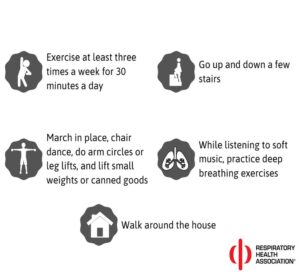Written by: Nathaniel Briscomb (Accredited Exercise Physiologist)
Chronic Respiratory Disease (CRD) is a group of disorders which affect the airways; including the lungs and passages that transfer oxygen from the mouth and nose. CRD is using experienced by sufferers with symptoms such as wheezing, shortness of breath, chest tightness and cough. There is a high prevalence of disability and multiple comorbidities with CRD which serve to reduce one’s physical capacity and health-related quality of life (Xiong et al., 2023).
Around 8.5 million (34%) Australians were estimated to have a chronic respiratory condition (AIHW, 2024). This included: 2.8 million (11%) people who were estimated to be living with asthma and 638,000 (2.5%) people who were estimated to be living with COPD (ABS 2022).
This has a significant impact on the Australian health care system, with an estimated $836.1 million (1.8% total expenditure) spent just on treating the most common respiratory disease (AIHW, 2024). The real cost is in the impact on the lives of people living with Chronic Respiratory Disease.
The great news is that Exercise Physiology plays a vital role in the treatment of those who suffer from symptoms of CRD.
The research shows that cardiovascular exercise, strength training, high-intensity interval training (HIIT), and newer approaches like aquatic exercise have been shown to effectively enhance exercise capacity, physical fitness, and lung function in individuals with CRD (Xiong et al., 2023).
In this article, we will describe the benefits of exercise in this population and provide key tips for managing respiratory conditions.

Why It’s Important to Exercise when living with Chronic Respiratory Disease
Exercise can improve overall health and help prevent disease by stimulating molecular change in our organs and tissues leading to improved function (Xiang et al., 2022).
A large amount of research in sports medicine supports the use of exercise programs for people with lung conditions especially for strengthening the immune system ACSM, 20. This can manifest in various ways for those with CRD such as shortness of breath during activity, poor recovery and a chest tightness (Xiang, 2022).
This happens because of problems like limited lung function, poor oxygen exchange, reduced blood flow, and weaker muscles. Exercise can reduce the symptoms related to CRD, leading to a better quality of life for those living with it.

Evidence Based Guidelines for Exercising with a Chronic Lung Conditions
Importance of Exercise
A reduction in exercise tolerance is one of the main complaints of people with chronic lung disease. Systematic reviews have consistently shown improved exercise tolerance after completing a period of tailored exercise.
If you have a lung condition like COPD, bronchiectasis, interstitial lung disease, lung cancer, or pulmonary hypertension, completing a pulmonary rehabilitation program can help you breathe better and be more active outside of the gym.
Create a Structured Plan
Using a tailored exercise program prescribed by an Accredited Exercise Physiologist is the first step in combatting your illness. Certain variables require individual prescription to optimise your needs, such as how hard you train, how long for and what type of exercise you perform are some of the ways an exercise professional will individualise your program.
The prescription of each person should be based on results from tests of exercise capacity. If you’re seeking assistance with this, please feel free to ask one of our friendly Exercise Physiologists.
Home based exercise training

To maintain progress during pulmonary rehabilitation, aim to walk daily for 30 minutes at a pace that feels like you are getting somewhat breathless. If 30 minutes at once is too much, split it into shorter sessions (e.g., 2 x 15 minutes or 3 x 10 minutes), gradually working toward a continuous 30-minute walk.
Strength exercises, like those done in a gym-based rehab program, can be performed as a circuit at least three times per week.
It’s important to progress your home exercises in line with a rehabilitation program by gradually increasing intensity, duration, or repetitions as advised.
Clinical considerations for exercising with a respiratory condition.
If you are unwell (e.g., with the flu or a chest infection) or have eaten a main meal within the past 1–2 hours, consider delaying your exercise. Stop and rest if you experience any unusual symptoms such as excessive shortness of breath, chest, neck or arm pain (stop immediately and seek medical advice), extreme fatigue, dizziness, nausea, light-headedness, or an irregular heartbeat or palpitations.
Use of Supplemental Oxygen and Bronchodilators
In people with moderate to severe lung disease, studies have shown that using oxygen during exercise helps them breathe more efficiently (Ekrom et al., 2016). It reduces the amount of air they need to move in and out, delays the feeling of breathlessness, and allows them to exercise for longer. Because of this, using oxygen during exercise training may be helpful.
Conclusion
CRD results in airflow obstruction and a marked reduction in exercise capacity and health-related quality of life. Affecting over 1 in four Australians aged over 75 years, the most common lung disease remains one of the major causes of disability and death in the world. For individuals with CRD, an exercise program of aerobic and strength exercises delivered over at least an 8-week period, that engages lower and upper body skeletal muscles, will deliver significant health improvements.
If you’re unsure how to incorporate recovery into your routine or need advice on reaching your fitness goals, our team of Accredited Exercise Physiologists in Balwyn North are here to guide you every step of the way. Please feel free to reach out to us at 9857 3007.
References
1. Xiong, T., Bai, X., Wei, X., Wang, L., Li, F., Shi, H., & Shi, Y. (2023). Exercise rehabilitation and chronic respiratory diseases: effects, mechanisms, and therapeutic benefits. International Journal of Chronic Obstructive Pulmonary Disease, 1251-1266.
2. Australian Bureau of Statistics. National Health Measures Survey [Internet]. Canberra: ABS; 2022-24 [cited 2025 May 20]. Available from: https://www.abs.gov.au/statistics/health/health-conditions-and-risks/national-health-measures-survey/latest-release.
3. Australian Institute of Health and Welfare. Chronic respiratory conditions [Internet]. Canberra: Australian Institute of Health and Welfare, 2024 [cited 2025 May. 19]. Available from: https://www.aihw.gov.au/reports/chronic-respiratory-conditions/chronic-respiratory-conditions
4. Xiang X, Huang L, Fang Y, Cai S, Zhang M. Physical activity and chronic obstructive pulmonary disease: a scoping review. BMC pulmonary medicine. 2022 Aug 5;22(1):301.
5. Garvey C, Bayles MP, Hamm LF, Hill K, Holland A, Limberg TM, Spruit MA. Pulmonary rehabilitation exercise prescription in chronic obstructive pulmonary disease: review of selected guidelines: an official statement from the American association of cardiovascular and pulmonary rehabilitation. Journal of cardiopulmonary rehabilitation and prevention. 2016 Mar 1;36(2):75-83.
6. Ekstrom M, Ahmadi Z, Bornefalk-Hermansson A, Abernethy A, Currow D. Oxygen for breathlessness in patients with chronic obstructive pulmonary disease who do not qualify for home oxygen therapy. Cochrane Database Syst Rev. 2016;11:CD006429.
